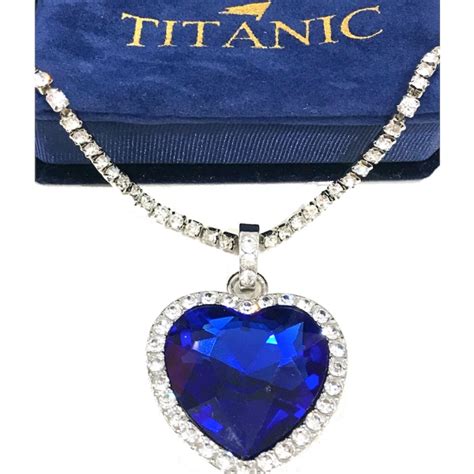
After over a century submerged in the Atlantic Ocean, what is believed to be the real-life inspiration for the “Heart of the Ocean” necklace featured in the film Titanic has been located, thanks to advanced underwater scanning technology. The potentially priceless necklace was detected within the debris field of the Titanic wreckage.
The elusive “Heart of the Ocean,” a diamond necklace capturing the public imagination since the release of James Cameron’s blockbuster film, may finally be more than just a fictional treasure. Magellan, Ltd., a firm specializing in deep-sea mapping, has revealed images suggesting the presence of a necklace crafted with a shark tooth believed to be encased in gold. The discovery was made during a comprehensive scan of the Titanic wreckage in 2022.
The scanned images, unveiled recently, are currently being further analyzed by experts. The exact composition and value of the necklace remain unknown, but the find has ignited excitement among historians and treasure hunters alike.
Magellan utilized two remotely operated vehicles (ROVs) to meticulously create a high-resolution 3D map of the entire Titanic debris field. This comprehensive undertaking resulted in over 700,000 images. The ROVs worked tirelessly, traversing the ocean floor at a depth of nearly 12,500 feet, with the intention to produce a complete picture of the wreckage site, offering unprecedented detail. It was during this extensive mapping process that the unusual necklace was identified.
“We scanned the entire Titanic wreckage and debris field,” stated Gerhard Seiffert, Magellan’s CEO. “Within that data, we were able to find an image of what looks incredibly like a megalodon tooth encased in gold. It’s quite extraordinary.”
The location of the necklace within the debris field is significant, as it suggests the piece was likely lost during the ship’s sinking. Whether the necklace belonged to a first-class passenger or a member of the crew is currently unknown, and its discovery raises numerous questions about its origins and history.
The artifact, if confirmed to be genuine, could offer profound insights into the lives of those aboard the ill-fated vessel. Further investigation will be required to ascertain the necklace’s authenticity and historical significance. The recovery of the object itself presents substantial legal and ethical challenges. The wreck site is located in international waters, and various treaties and agreements govern the salvage of artifacts from the Titanic.
The discovery comes more than three decades after the Titanic’s wreckage was first located in 1985 by a joint French-American expedition led by Robert Ballard. Since then, numerous artifacts have been recovered from the site, but the “Heart of the Ocean,” whether the fictional or a real-world counterpart, has remained an object of fascination.
The 1997 film Titanic greatly amplified the allure of the “Heart of the Ocean,” depicting a fictional, priceless blue diamond necklace lost during the tragedy. While this new discovery is not the blue diamond of the film, its unique design and potential value make it a compelling find in its own right. The “Heart of the Ocean” in the film served as a MacGuffin driving much of the narrative forward. It represented both wealth and lost love, becoming deeply ingrained in popular culture.
The current find evokes the dramatic narrative of the film, fueling speculation about the identity of the owner and the stories behind the lost treasure. The possibility of a real-life “Heart of the Ocean” adds another layer of intrigue to the already captivating history of the Titanic.
Experts believe the shark tooth is from a Megalodon, an extinct species of giant shark that lived millions of years ago. Megalodon teeth are often found as fossils, but the presence of the shark tooth encased in gold is an extremely rare and unusual find.
The discovery has generated considerable excitement among maritime historians and researchers. “This is an incredible discovery,” said Dr. Emily Carter, a marine archaeologist specializing in Titanic-era artifacts. “If authenticated, this necklace could provide invaluable information about the passengers and the cultural context of the voyage.”
The analysis of the images and any potential recovery operation would necessitate a collaborative effort between Magellan, historical experts, and potentially government agencies. Legal issues surrounding ownership and preservation will also need to be addressed.
The Titanic disaster, which resulted in the loss of over 1,500 lives, continues to resonate deeply with people worldwide. The rediscovery of artifacts from the wreck serves as a poignant reminder of the human stories behind the tragedy. This potential “Heart of the Ocean” offers a tangible connection to the past, sparking renewed interest in the events of that fateful night in April 1912.
The find will undergo extensive analysis to determine its authenticity, composition, and provenance. The potential recovery of the necklace will require careful planning and execution, considering the delicate nature of the artifact and the challenging conditions at the wreck site.
The Titanic remains a protected site, and any salvage operations must adhere to strict guidelines and regulations. The discovery of the potential necklace underscores the importance of preserving the wreck site and respecting the memory of those who perished.
Further Contextualization and Analysis:
The discovery of the potential “Heart of the Ocean” necklace transcends the mere recovery of a valuable artifact. It delves into the realms of historical investigation, technological innovation, ethical considerations, and the enduring fascination with the Titanic. To fully appreciate the significance of this find, we must consider the broader context in which it occurs.
-
Technological Advancement: The discovery is a testament to the remarkable advancements in underwater scanning and mapping technology. Magellan’s use of ROVs to create a detailed 3D model of the Titanic wreckage demonstrates the capabilities of modern technology to explore and document previously inaccessible environments. These technologies are not only valuable for historical research but also for various applications, including ocean exploration, resource management, and disaster response.
-
Historical Significance: The Titanic represents a pivotal moment in history, marking both technological achievement and devastating loss. The artifacts recovered from the wreck provide tangible links to the lives of those who perished and offer insights into the social, economic, and cultural context of the early 20th century. Each artifact tells a story, and the potential “Heart of the Ocean” necklace could unlock new details about the passengers, their possessions, and the events leading up to the disaster.
-
Ethical Considerations: The recovery of artifacts from the Titanic raises complex ethical questions. On one hand, the retrieval of these objects allows for their preservation and study, contributing to our understanding of history. On the other hand, the wreck site is considered a memorial to those who lost their lives, and any disturbance of the site must be approached with sensitivity and respect. The legal and ethical frameworks governing salvage operations must strike a balance between historical preservation and the dignity of the deceased.
-
The Enduring Fascination with the Titanic: The Titanic continues to capture the public imagination more than a century after its sinking. This enduring fascination stems from various factors, including the magnitude of the tragedy, the human stories of heroism and sacrifice, and the allure of lost treasure. The fictionalized account of the Titanic in popular culture, particularly James Cameron’s film, has further amplified the ship’s iconic status. The discovery of a potential “Heart of the Ocean” necklace taps into this existing interest, fueling speculation and rekindling the desire to understand the events surrounding the disaster.
Legal and Ownership Issues:
The legal landscape surrounding the Titanic wreckage is complex, involving international treaties, maritime law, and various stakeholders with potential claims to recovered artifacts. The wreck site is located in international waters, meaning that no single nation has exclusive jurisdiction over it.
-
International Agreements: Several international agreements address the preservation and management of shipwrecks, including the UNESCO Convention on the Protection of the Underwater Cultural Heritage. These agreements aim to prevent the looting of shipwrecks and promote responsible archaeological practices.
-
Maritime Law: Maritime law governs salvage rights and ownership of recovered artifacts. Generally, the party that discovers and salvages a shipwreck has a claim to the recovered items, subject to certain conditions and limitations. However, the application of maritime law to the Titanic is complicated by the historical significance of the wreck and the presence of human remains.
-
Stakeholders: Numerous stakeholders have an interest in the Titanic wreckage, including the descendants of the passengers and crew, governments, maritime museums, and salvage companies. Determining the ownership of recovered artifacts requires careful consideration of these competing interests and the applicable legal frameworks.
The Role of Technology in Underwater Exploration:
Magellan’s discovery highlights the transformative role of technology in underwater exploration. Advances in robotics, sonar, and imaging have enabled scientists and researchers to explore the depths of the ocean with unprecedented precision and efficiency.
-
Remotely Operated Vehicles (ROVs): ROVs are unmanned underwater vehicles that can be controlled remotely from a surface vessel. They are equipped with cameras, sensors, and manipulators, allowing them to perform tasks such as mapping, surveying, and collecting samples.
-
Sonar Technology: Sonar (Sound Navigation and Ranging) uses sound waves to create images of the seafloor. Multi-beam sonar can generate detailed 3D maps of underwater terrain, revealing shipwrecks, geological features, and other objects of interest.
-
Underwater Imaging: High-resolution underwater cameras and imaging systems allow researchers to capture detailed images and videos of the marine environment. These images can be used to identify and document artifacts, study marine life, and monitor environmental conditions.
The integration of these technologies has revolutionized underwater exploration, opening up new possibilities for scientific discovery, resource management, and historical preservation.
The Future of Titanic Research:
The discovery of the potential “Heart of the Ocean” necklace represents a significant milestone in Titanic research, but it also raises new questions and challenges. Future research efforts will likely focus on:
-
Authenticating the Necklace: Further analysis is needed to determine the authenticity of the necklace and its origins. This may involve studying the materials used to create the necklace, comparing it to historical records, and consulting with experts in jewelry and maritime history.
-
Recovering the Necklace: If the necklace is deemed authentic and historically significant, efforts may be made to recover it from the wreck site. This would require careful planning and execution, considering the delicate nature of the artifact and the challenging conditions at the site.
-
Preserving the Wreck Site: The Titanic wreck site is a fragile and irreplaceable resource that must be protected for future generations. Ongoing efforts are needed to monitor the condition of the wreck, prevent looting, and promote responsible tourism.
-
Educating the Public: The Titanic continues to be a source of fascination and inspiration for people around the world. Educational initiatives can help to raise awareness about the history of the Titanic, the importance of maritime preservation, and the ethical considerations surrounding the exploration of shipwrecks.
The enduring legacy of the Titanic is not just about the tragedy itself but also about the lessons we can learn from it. By studying the wreckage, preserving its artifacts, and sharing its stories, we can honor the memory of those who perished and gain a deeper understanding of our shared history.
Frequently Asked Questions (FAQ):
Q1: Is this the actual “Heart of the Ocean” necklace from the Titanic movie?
A: No, the necklace discovered is not the fictional blue diamond necklace depicted in the 1997 film Titanic. While inspired by the film, this is a real necklace containing a shark tooth encased in gold, discovered within the Titanic’s debris field. The film’s “Heart of the Ocean” served as a plot device, whereas this discovery represents a tangible artifact from the actual shipwreck.
Q2: How was the necklace found, and who found it?
A: Magellan, Ltd., a deep-sea mapping company, discovered the necklace during a comprehensive scan of the Titanic wreckage in 2022 using advanced remotely operated vehicles (ROVs). The ROVs captured over 700,000 images, which were then analyzed to identify the unusual object.
Q3: What is the necklace made of?
A: Initial analysis of the images suggests that the necklace contains a Megalodon tooth encased in gold. Megalodon was an extinct species of giant shark. Further investigation is needed to confirm the composition and assess its value.
Q4: Where is the Titanic wreckage located?
A: The Titanic wreckage lies at a depth of approximately 12,500 feet (3,800 meters) in the North Atlantic Ocean, about 370 miles (600 kilometers) off the coast of Newfoundland, Canada. The location is in international waters.
Q5: What are the legal and ethical implications of recovering the necklace?
A: Recovering artifacts from the Titanic is subject to various international agreements and maritime laws. Ethical considerations also play a significant role, given that the wreck site is considered a memorial to those who lost their lives. Any salvage operation must adhere to strict guidelines and regulations, respecting the memory of the victims and preserving the historical integrity of the site. Legal ownership of any recovered artifacts is also subject to interpretation and may involve multiple stakeholders, including governments and descendants of passengers.









